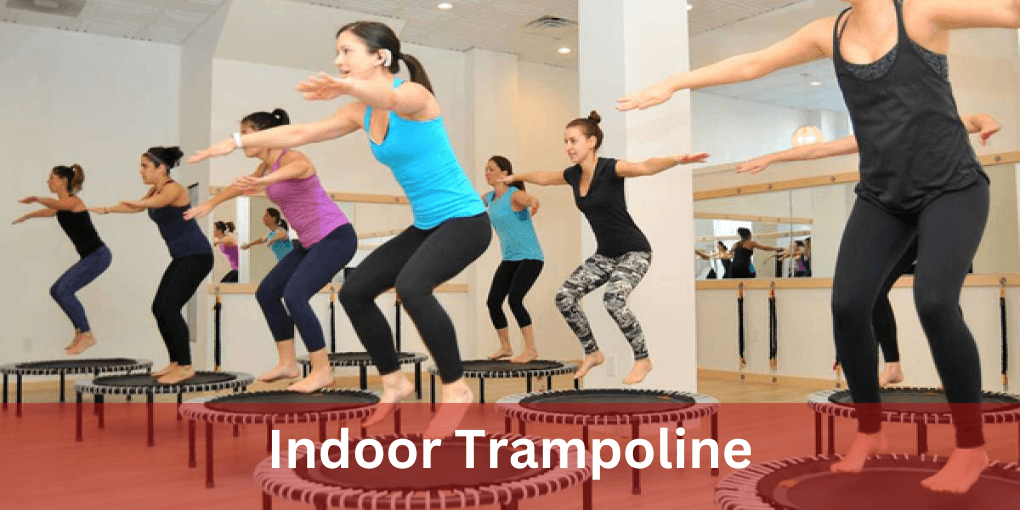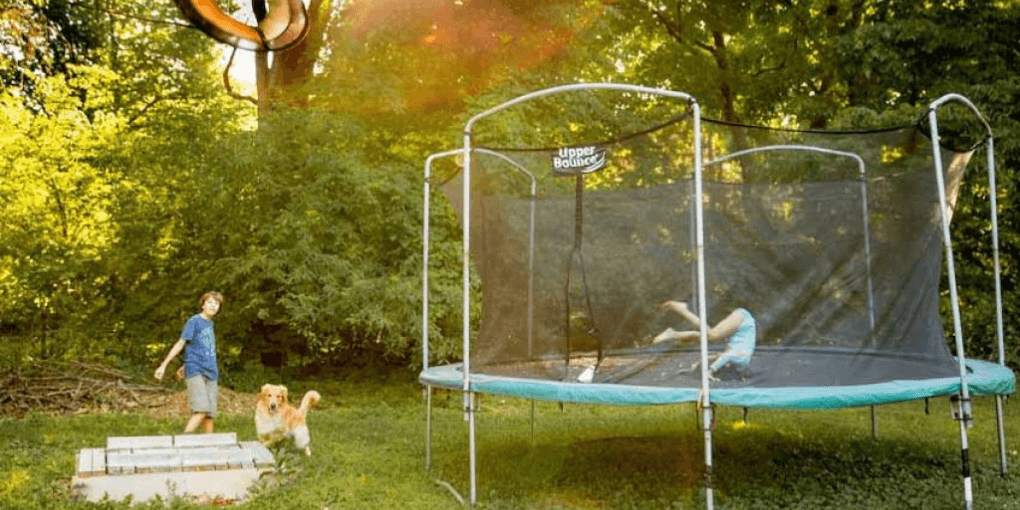Why Indoor Trampoline Are the Perfect Fitness Solution
Indoor trampoline is becoming popular for their ability to provide a fun and exciting workout.

These trampolines offer a low-impact alternative to traditional exercises. It makes them a great option for people of all ages and fitness levels.
In this blog post, from my long-time experience, I’ll explore the benefits of indoor trampolining, safety tips for using them, and how to choose the right trampoline for your needs.
I’ll also take a look at indoor trampoline parks, compare indoor and outdoor trampolines, and explore how trampolining can be an effective form of exercise.
By the end of this post, you’ll have a better understanding of why indoor trampolines are an excellent addition to any fitness routine.
What an indoor trampoline?
An indoor trampoline is a piece of exercise equipment that consists of a sturdy metal frame and a large, bouncy jumping mat.
The mat is attached to the frame by numerous coiled springs, which give the trampoline its bounce.
Indoor trampolines are designed to be used indoors, either in a home or gym setting, and are often smaller in size than outdoor trampolines.
They are used for recreation and fitness purposes, as jumping on a trampoline is a fun and effective way to improve cardiovascular health, strengthen muscles, and burn calories.
Indoor trampoline can also be used for low-impact rehabilitation exercises. It makes them versatile pieces of equipment for people of all ages and fitness levels.
Brief history of trampolining
Trampolining, as I know it today, originated in the early 20th century.
In 1934, two American gymnasts, George Nissen, and Larry Griswold invented the trampoline after observing trapeze artists using a net to bounce and perform acrobatic stunts.
The first trampoline was made by stitching together a canvas sheet and some rubber springs, which were taken from a car.
Nissen and Griswold soon recognized the potential of their invention for use in gymnastics training and competition.
In 1947, the first national trampoline championships were held in the United States.
In 1964, trampolining made its Olympic debut as a demonstration sport, and in 2000, it became an official Olympic event.
Over the years, trampolines have undergone various technological advancements.
It has added various safety features such as padding and enclosure nets.
Today, trampolining is a popular recreational activity and a recognized competitive sport. People from every corner of the world enjoy it.
Indoor trampoline has also gained popularity. It allows people to enjoy trampolining in the comfort of their own homes or in specialized indoor trampoline parks.
Benefits of Indoor Trampolining
Indoor trampolining offers a range of physical and mental benefits that make it a popular exercise choice. Here are some of the main benefits:
Low-Impact Exercise
One of the biggest advantages of trampolining is that it provides a low-impact workout. It makes a great option for people with joint pain or mobility issues.
Unlike high-impact exercises like running, trampolining puts less stress on the joints while still providing a challenging cardiovascular workout.
Full-Body Workout
Trampolining engages muscle groups throughout the body. It is a great form of full-body exercise.
Jumping on a trampoline requires the use of the legs, core, arms, and back muscles to stabilize the body and maintain balance.
Improved Cardiovascular Health
Jumping on a trampoline gets the heart rate up, improving cardiovascular health and endurance.
A 2018 study published in the International Journal of Sports Medicine found that trampoline exercise led to significant improvements in cardiovascular fitness among young adults.
Stress Relief
Trampolining can be a fun and exhilarating way to blow off steam and relieve stress.
Physical activity stimulates the release of endorphins. It can elevate mood and lessen depressive and anxious sensations.
Increased Coordination and Balance
Jumping on a trampoline requires coordination and balance. Regular trampolining can help improve these skills over time.
This can translate to improved performance in other sports or activities that require coordination and balance.
Safety Tips for Indoor Trampolining

While trampolining can be a fun and effective form of exercise. To limit the danger of injury, it is critical to adopt safety precautions. Get some safety tips for indoor trampolining:
Use a Trampoline with Safety Features
When purchasing an indoor trampoline, look for one with safety features such as padding around the frame and springs, and a safety enclosure net to prevent falls.
Supervise Children at All Times
Children should always be supervised when using an indoor trampoline. Younger children should not use trampolines unsupervised.
One Person at a Time
Only one person should use the trampoline at a time, to reduce the risk of collisions and injuries.
No Stunts or Flips
Attempting to perform stunts or flips on a trampoline can be dangerous and increase the risk of injury. Stick to basic jumps and exercises.
Clear the Area Around the Trampoline
Make sure the area around the trampoline is clear of obstacles, furniture, and other hazards that could cause injury.
Warm-Up Before Use
Stretching and warming up before using an indoor trampoline can help prevent muscle strains and other injuries.
Avoid Using When Tired or Ill
Avoid using an indoor trampoline when tired or ill, as fatigue or illness can increase the risk of injury.
Choosing the Right Indoor Trampoline
Choosing the right indoor trampoline is important to ensure that you get the most out of your trampoline experience.
Here are some factors to consider when choosing an indoor trampoline:
Size
Consider the size of the trampoline and the space you have available in your home. Trampolines come in various sizes, so choose one that fits your space and allows for safe jumping.
Weight Capacity
Check the weight capacity of the trampoline to ensure that it can safely support the weight of all users.
Safety Features
Look for an indoor trampoline with safety features such as padding around the frame and springs, and a safety enclosure net to prevent falls.
Durability
Choose a trampoline made with durable materials that can withstand regular use and provide long-lasting enjoyment.
Brand Reputation
Do your research and choose a reputable brand with a history of producing quality trampolines with strong safety records.
Budget
Indoor trampolines come at various price points. So consider your budget and choose a trampoline that provides good value for money without compromising on safety or quality.
Indoor Trampoline Parks
In recent years, indoor trampoline parks have grown in popularity. They offer a fun and exciting way to enjoy trampolining with friends and family. There are some things to know about indoor trampoline parks:
What is Indoor Trampoline Parks?
Indoor trampoline parks are facilities that offer a range of trampoline-based activities, including free jumping, dodgeball, basketball, and foam pits.
Safety Features
Indoor trampoline parks usually have strict safety measures in place, including safety enclosure nets, padding, and trained staff to monitor the activity.
Age and Weight Restrictions
Indoor trampoline parks may have age and weight restrictions for certain activities to ensure safety. It’s important to check these restrictions before attending.
Cost
The cost of indoor trampoline parks varies depending on the location and activities offered. Many parks offer discounted rates for group bookings or frequent visitors.
Benefits
Indoor trampoline parks offer a fun and social way to exercise while also providing the benefits of trampolining. It’s a great way to spend time with friends and family while getting active.
Precautions
As with any physical activity, it’s important to take precautions to reduce the risk of injury.
Follow the rules and guidelines set by the indoor trampoline park, warm up before jumping, and avoid attempting stunts or tricks beyond your skill level.
Indoor Trampoline vs. Outdoor Trampoline
When considering purchasing a trampoline, you may wonder whether an indoor or outdoor trampoline is the right choice for you.
Here are some differences between indoor and outdoor trampolines to help you make an informed decision:
Location
The most obvious difference between indoor and outdoor trampolines is the location.
Indoor trampolines are designed to be used inside the home, while outdoor trampolines are designed for outdoor use.
Size and Shape
Indoor trampolines are smaller in size and have a circular or rectangular shape to fit in smaller spaces.
Outdoor trampolines come in various sizes and shapes, including oval, rectangular, and round.
Weather
Outdoor trampolines are exposed to the elements. It can be affected by weather conditions such as rain, wind, and sun.
Indoor trampoline can be used year-round regardless of weather conditions.
Safety Features
Both indoor and outdoor trampolines should have safety features, such as padding and enclosure nets, to prevent injuries.
Indoor trampolines may have more safety features due to the limited space available and the need to ensure safety in a confined area.
Cost
Indoor trampolines are more expensive than outdoor trampolines due to the added safety features and design elements required for indoor use.
Convenience
Indoor trampolines are more convenient for those who don’t have a lot of outdoor space or who prefer to exercise indoors.
Outdoor trampolines can provide a fun outdoor activity for families and children.
Conclusion
An indoor trampoline can provide a fun and exciting way to stay active and fit. It also is a great source of entertainment for children and adults alike.
Whether you are considering an indoor trampoline for recreational or fitness purposes. It’s important to prioritize safety and choose the right trampoline for your needs.
With proper use and safety measures in place, an indoor trampoline can be a valuable addition to any home or fitness routine.
Whether you’re bouncing to have fun or for a great workout, an indoor trampoline is a versatile piece of equipment that can offer many benefits.
So, jump in and start bouncing your way to a healthier and happier lifestyle!
FAQs
Yes, indoor trampolines are generally safe for children when used according to safety guidelines. Always supervise young users, and consider trampolines with safety enclosures for added protection.
The space required varies by trampoline size. Measure the available space in the room and ensure there is enough clearance around the trampoline to prevent accidents.
Assembly difficulty varies by model. Some indoor trampolines are designed for easy assembly and can be assembled solo. However, having a second person can make certain steps, like attaching springs, easier.
Indoor trampolines are suitable for use on carpeted floors. However, ensure the surface is stable, and consider placing a protective mat underneath to prevent damage to the carpet.


